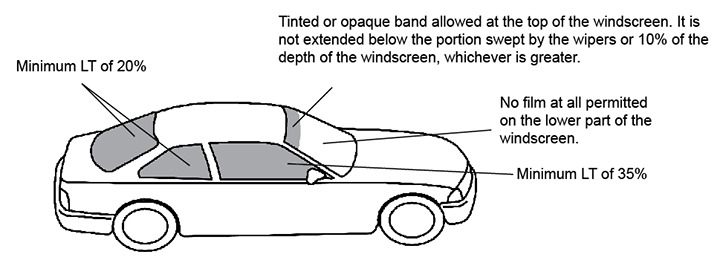Vehicle windscreen and window tinting
Tinting windscreens and windows can reduce vision and affect safe driving.
The ACT uses the national standard for applying film to vehicle glass for tinting.
These standards use light transmittance (LT) as a measurement of tint.
This requires a coating or tint applied on the:
- driver and front passenger side windows to have a LT of at least 35%
- rear passenger side windows and rear window must have a LT at least 20%.
You can also place a strip at the top of the front windscreen. This strip has no minimum LT requirements. The placement of the tint strip of at the top of the windscreen can be either:
- the area above the highest point of the windscreen that is swept by a windscreen wiper
- the upper 10% of the windscreen.
You can't add a tint that reduces the LT to any other part on the windscreen.
Glazing used in an interior partition of a motor vehicle must have LT of at least 70%.

Truck, commercial vehicles and buses
Tinting on the windows next to the driver and passenger should be the same as passenger vehicle. They must have a LT of at least 35%
Goods carrying vehicles such as trucks and utilities carry loads behind the driver. They don't have the same requirements for the rear window as passenger vehicles. There is no minimum LT for windows behind the driver on these vehicles.
There are also no limits for:
- windows to the rear of the driver if the vehicle is a bus, stretch limousine, ambulance or hearse
- windows with glazing or coating fitted before 1 October 1996 behind the rear of the driver's seat
- windows with glazing or coating next to the rear of an area of a motor vehicle designed to carry goods
- a strip at the top of the windscreen, as long as it's above the arc swept by the windscreen wipers or at the upper 10% of the windscreen.
For information about heavy vehicle modification, visit the National Heavy Vehicle Regulator website.
